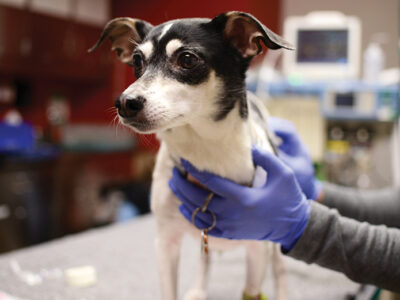“The future lies in these artificial tanks,” says Dr. Leon Weiss, the Lambert Professor of Cell Biology at the School of Veterinary Medicine. Weiss is referring to plastic tanks designed for growing fish, and as director of a feasibility study to be undertaken at the vet school, he and his colleagues will have an opportunity to see whether that future can get started now.
In the $450,000 study, funded by the Delaware River Port Authority (DRPA), four insulated, 2,400-gallon hexagonal tanks will be built at the vet school, each with its own heating and circulating system. From these “teacup”-size modelswhich should yield some 3,000 to 5,000 pounds of fish a yearWeiss hopes to fine-tune the technology and determine the viability of commercial-scale tank fish farming. The project will also offer students hands-on learning in the growing field of aquaculture.
“We
want to shape this industry as it’s developing, and then train students
to serve it,” he says. “Just as we train students to take care of dogs
and cats and chickens, we’d like to train them to take care of fish. If
we’re lucky enough to do work good enough for the DRPA to attract
commercial aquaculture, we can use those fish farms to train students”just
as hospitals are used to train medical students. And someday, perhaps,
those fish farms may provide the restaurants and markets of the
Philadelphia area with locally grown, competitively priced fish.
While
commercial fish-farming in this country has traditionally relied on
such natural waterways as the catfish-friendly ponds of the South and
Idaho’s trout-friendly Snake River, Weiss notes that in the artificial
tanks, scientists and farmers can control nutrients, temperature, and
other factors essential for fish growth and survival.
The
project was spawned several years ago when the venerable Philadelphia
Navy Yard was decommissioned and city officials began hunting for ways
to put the suddenly-idle land along the Delaware River to good use. Out
of that search came the unlikely partership of the DRPA and the vet
school.
Neither
party has rushed blindly into this venture. First, the Wharton School
conducted a marketing study in the Philadelphia/New Jersey area, and
concluded that a profitable market for fish did indeed exist. The next
hurdle is to make the technology of fish farming profitable, and to that
end the vet school has enlisted the School of Engineering and Applied
Sciences, the Graduate School of Fine Arts, and Wharton.
Weiss
acknowledges that to grow fish now “costs almost as much as when you
sell them.” But he says he is quite “confident that we can make this
technology better.” The tanks’ hexagonal shape, for example, should
allow unused feed to be collected and reused better than the usual
rectangular tanks; insulation should keep the heating costs down; covers
will prevent wasteful evaporation; and a new system of pumping in
oxygen taken from the air should not only be cheaper but prevent the
fish from suffering the burns that sometimes result from bubbled-in
liquid oxygen. “In this business,” he says, “the difference between
success and failure can be measured in pennies.”
Assuming that the feasibility study results in a thumbs-up, the DRPA will begin franchising space for the tanks—either in the Navy yard or some other place. The beauty of tank farming is that you can put the tanks in abandoned warehouses, airplane hangers—almost anywhere.
And in the meantime, says Weiss: “We are poised as a panther ready to get started.”




